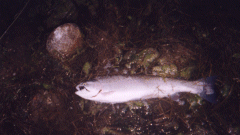
April, 2004
4/5-7: It was the thought of an early spring trip to the fabled Miracle Mile on the North Platte that drove us to Wyoming on Monday. Five and a half hours later we were casting into what we'd seen on earlier trips as a mucky, filthy mess of irrigation release water, but which today had turned clear as a glass of gin. The flow had also dropped dramatically, and while we don't have stats on the actually release rate from Kortes Dam, the stream was visibly down at least 200 c.f.s. from earlier visits. That had both positive and negative connotations for the fishing.
The good news was that fish could obviously see objects (a fly) for further distances in the water, while the bad new was that the holding areas by the banks had completely disappeared. On balance the whole situation probably pretty much evened out. The first few casts into a favorite run from earlier trips yielded absolutely no strikes, and it was clear the fish had shifted to deeper runs and pools. But in the next downstream location there came a fat sixteen inch brown to hand and probably the best fish (released) on the trip - a twenty inch plus snaggle toothed male cutthroat.
Both took a copper cone headed olive colored magic bugger which proved to be
the best fly of the trip. Streamer fishing continued to be the most
productive method on this stream - for me - despite the changes to the habitat
with the reduced flows and increased clarity. The best colored fly was the
olive, followed by a
black/dark green model, and lastly a ginger colored one that was much more
successful last time around.
Each afternoon around 4:00 some type of hatch occurred. Exactly what the fly was I still don't know. It seemed to be a dark winged mayfly of some type floating on the surface, but it was very hard to identify and none were actually in the air. Using a floating WRS and trailing antenna type bead head caddis brought strikes to both flies, but lord only knows what caused the strikes. With one (very heavy) exception fish taking the surface fly and/or nymph were immature rainbows in the 8-12 inch range.
 OK. Fish sizes and
quantities. The bulk of the releases were rainbows in a 12-16 inch range -
surface flies takers excepted as noted above. Next followed browns in
roughly the same size range. I only released the one cutthroat although
may have played a few more - long releases - that fought in the same style as the first one.
While trying to open my camera as I attempted to photograph a really massive
rainbow of probably 5-6 pounds, the fish detached itself prior to achieving
immortality through the picture. Also had on another whopper of a
"moving" snag that probably was even larger than the previous
mentioned rainbow.
OK. Fish sizes and
quantities. The bulk of the releases were rainbows in a 12-16 inch range -
surface flies takers excepted as noted above. Next followed browns in
roughly the same size range. I only released the one cutthroat although
may have played a few more - long releases - that fought in the same style as the first one.
While trying to open my camera as I attempted to photograph a really massive
rainbow of probably 5-6 pounds, the fish detached itself prior to achieving
immortality through the picture. Also had on another whopper of a
"moving" snag that probably was even larger than the previous
mentioned rainbow.
So bigger fish really do exist here. Saw a couple monsters in the range of over two feet long in a deeper pool but could not begin to interest either of them. The spring rainbows that are supposed to run up from Pathfinder Reservoir may either not be up here yet - or may simply stop lower down in the stream to set their redds. With poor runoffs lately, the gap between Pathfinder and Kortes has grown to the point that one must assume the spawning areas are spreading out considerably.
 Most fascinating
experience. Landing what was easily a ten pound "brownbow" -
a.k.a. a common carp. Had never seen the species before on this stream,
but I was fortunate to have actually mouth hooked this one after missing
several others while casting to them in a big pod as they were drifting about in
a large eddy near the braids. I really enjoy trying to hook carp despite
their unsavory appearance and reputation.
Most fascinating
experience. Landing what was easily a ten pound "brownbow" -
a.k.a. a common carp. Had never seen the species before on this stream,
but I was fortunate to have actually mouth hooked this one after missing
several others while casting to them in a big pod as they were drifting about in
a large eddy near the braids. I really enjoy trying to hook carp despite
their unsavory appearance and reputation.
So what tactics seem to work well here? Apparently streamers are as good
a choice as anything else. Every trip has been successful using that type of
fly.
"Chuck and duck" casting can be the rule due to winds that seem to
come from all directions and change at a moment's notice. Under these
conditions it helps to be ambidextrous, and the fisherman would be well served
by learning to cast the streamer with either hand to avoid the "duck"
when doing the chuck depending on which side of the stream one is fishing.
Walking downstream and making a cast every few feet allows the fisher person to
sweep the streamer past the nose of every fish in a run, and the technique can
be quite effective. I'd estimate that ten to fifteen fish an hour should
be hooked while casting this way.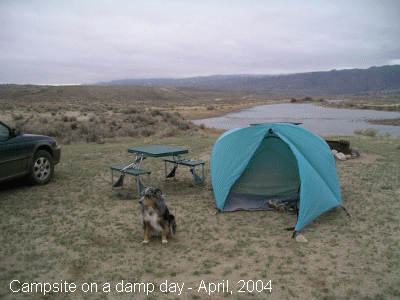
The water in the spring is quite cold, and that necessarily limits what hatches do occur. Doubtless many varieties of insects live in this rich water, but the effectiveness of attempting to match those flies may be even more severely limited when the murkiness returns during the summer months as the water warms.
What else is worth mentioning? For anyone who has not yet enjoyed this fine stretch of river it's notable that the Wyoming Department of Wildlife has done a remarkable job of making the area very user friendly. There are good gravel roads down both sides of the stream, many sturdy, well maintained restrooms exist, plenty of picnic tables and fire pits are available, and best of all there is unrestricted and absolutely free camping anywhere along the river.
For those who take the occasional fish to eat, the limit is two fish in possession, only one of which may be in excess of 20 inches. Unhappily there is no restriction on the type of lure or bait which can be used here, and it's obvious from the piles of worm containers left on the banks that many fish get yanked and killed - and I'd suspect poaching is a common problem. As with most fishing areas not restricted to catch and release or flies & lures only, the local "bubba's" do their best to make a mess of a good situation. Too many Bud bottles & cans and related types of trash are left behind by these morons, and that's about the only thing that mars what would otherwise be something of a fisherman's paradise.
4/12-14: Ah, another week, another great tailwater experience. This time it's the Green below Flaming Gorge. Nice weather for sunbathing generally means tougher fishing as tippets become more visible, etc. and hatches are more subdued. The olives still are not active yet though we did see a few in the air and skating on the surface late in the afternoon on the first two days.
Water temperatures are cold - as in really cold. 38 degrees was the latest reading below the dam which makes for very chilly wet wading. Flow level apparently is in the mid 800's as it has been most of the spring. Low lying snow has pretty much melted off so the stream's not getting cloudy from runoff in the upper stretches.
We drove into the spillway parking lot in early afternoon on the first day, rigged up and began the standard hike downstream, casting streamers as we walked. A greenish magic bugger brought some fairly good results in the two miles we hiked and we released roughly a dozen fish with this method. All three species were noted in sizes ranging from 12-18 inches. As with most trout hooked on this river, the fish pretty much docilely allow themselves to be led to the bank to be released. As we headed back up river, the ongoing midge hatch intensified to the point that eddies were literally black with dead insect bodies.
I did a poor job of hatch matching initially and struggled until changing to a red quill comparadun which coloration seemed to closely imitate that of the naturals. It actually proved to be superior to a standard Griffith's gnat. At that point the catching got much better, and one eddy alone yielded a good dozen fish.
So it was a very good afternoon. Probably played at least 35-40 fish during the four hours on the water.
Next day turned out to be the poorest session of the trip. Again we did our regular hike up the canyon - this time from Little Hole. Early on a cicada paired with a smaller generic bead head nymph worked very well. Once the sun hit the water, however, things grew very quiet. Unfortunately the hikers were also out in droves, and it was hard to find water not intensely cast over. The next problem arose with the winds that came barreling up and down the canyon. Gusts were from everywhere making it impossible to place a fly efficiently. Even streamer fishing under these conditions proved unproductive. We must have walked a good eight miles over several hours and had only 15-18 fish played to break up the unpleasantness of the weather conditions.
Rather than do our planned hike down into upper "B" on the last morning, we chose to head back to the top of "A" since success had been decent there a day earlier. Heading down the trail at roughly 8:30 we were barely ahead of a major drift boat hatch. In fact the trips were so heavy this day that we once counted eighteen boats near one bend we were wading. It's not much fun trying to compete with those guys despite many of them attempting to give the shore people a bit of space to work.
More success resulted from using a ginger colored bugger this morning. Probably touched another dozen fish on our way casting down the couple of miles we walked. The midge hatch was not heavy this early in the day but using a series of different nymphs wasn't very productive either.
Eventually I changed back to a #22 comparadun and began having surprisingly good success on fish that I'd normally avoid casting over due to the delicacy needed to even get them to not spook when landing the fly and tippet on the surface. One pod yielded five fish ranging from 16-18 inches.
Three lessons that I re-learned here were - it's not necessary to use a standard midge imitation to be successful matching that type hatch, it's not necessary to avoid the bankside holding fish (on this river), and it is necessary to have straight tippets and leaders for delicate presentations. Whenever I failed to either throw a straight line - or whenever the tippet developed the slightest kink or curl, the fish were immediately put off.
4/20-21: Servicing the van in Denver provided an opportunity to loop back home via the South Platte basin and get in a bit of fishing on that tricky stream. Considered dropping down to Deckers, but the likelihood that part of the river had recovered from a major mud event last year was poor at best, so we proceeded up to Lake George with the intentions of fishing the Elevenmile tailwater. Scratch that idea. A $4 per day use fee is in effect and with the Spinney tailwater - free - and only another 20 miles or so away, we continued further upstream.
The weather was pretty rotten as is so often the case in the spring. This time it's again the wind that was shrieking over the flats around the stream that gave us fits. Most fishermen had already been driven from the water by the time we arrived at the lower lot, but we rigged up anyway and headed downstream in search of some deeper holes to plumb with wooly buggers.
No luck at the first couple of usually good spots, but shortly thereafter picked up two wonderfully large hen rainbows at the tail of a long, deep pool. Both were in the 18-20 inch range and looked to be spawning types that had run up from Elevenmile.
Continuing downstream and casting with a green magic bugger produced another half dozen fish including a very deep bodied cut that again was probably another spawn seeker from the lake.
Headed to the upper parking area, had a quick happy hour, and walked down to three of our favorite deep bends that usually produce several nice fish. Tonight it was not to be. The top hole brought to hand only one fourteen inch, and of all things, a tiny ten inch rainbow. Brave soul to chomp down on a fly that's one third the fish's size! (There are old pilots and there are bold pilots, but there are no old, bold pilots.)
Temperatures in the teens tried to chill us overnight, but the wonderful furnace in the van made sleeping quite pleasant. Today we revisited all yesterday's spots with even less success. No hatches were evident either day, and this morning the fish seemed even more sluggish. Wind picked up almost from the get go. At seven it was roughly 15 knots, at eight probably 20, and by nine it was back to yesterday's howling 30 plus.
Of the few fish released this morning only one was of note. It was a sixteen inch male rainbow spawner that looked to be eight inches deep - shaped exactly like a spawning sockeye - and it probably weighed a good three pounds. Have never seen another rainbow or steelhead like this one.
With snow splatting on the windshield we shortly gave up and headed back to the barn.
4/23-25: Despite pretty lousy fishing this was a fun weekend due to our visiting some places we'd not been before. It was also the first vanagon trip of the year which is another cause for celebration. Before Sue got off work Friday afternoon I took the dog down to the Roaring Fork above Sunlight Bridge and had what turned out to be the best success of the weekend. Walking down the bank and throwing a dark green bugger produced easily 20 fish played over the couple of hours we had available. Recent cold air temperatures had toned down the runoff and cleared the stream, and the fish were definitely on the prowl for food. Two thirds were browns in a range of 12-16 inches with the remaining trout being nice rainbows of roughly the same sizes.
On our way up McClure Pass we stopped for a few minutes to cast on the Crystal in Redstone but basically came away with only a couple of tentative strikes. Camped that night along the North Fork of the Gunnison just below its confluence with Anthracite Creek. The river was quite off color, and the few casts we tried were again ineffective.
Next morning we headed down through Delta to Montrose and finally turned into Ridgeway State Park intending to try this tailwater for the first time. The Uncompaghre's appearance here is outstanding. The park service did a superb job of artificially structuring the stretch through the area with wonderful rock and timber formations. Unfortunately we really didn't see many fish. They may be lying at the bottom of drops in deep water, and our casting efforts were close to futile. Had a handful of strikes on wooly buggers, while nymphing produced nothing at all. With the water being as clear as that of the Metolius in Oregon we could see virtually everywhere in the pools, and frankly, really saw only a few smaller fish holding.
Since this is catch & release only, it was quite disappointing to have
such poor success for what is reputedly good rainbow water.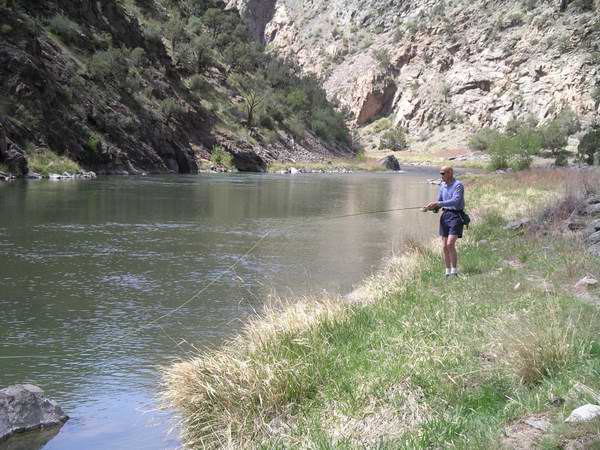
On to what would hopefully be bigger & better things. Using the state topo map we were able to find our way to the back roads leading to the Black Canyon of the Gunnison. Turning off on a fairly good jeep road we slowly drove to the top of the ridge above the canyon where the Duncan trail begins. As it was later in the day we simply did a bit of hiking, enjoyed dinner, and planned to head down to that river the next morning.
To put it mildly the trail was a bitch both down and back. Although
only a 1.5 mile descent, the steepness and difficulty made it a 50 minute effort
going in and an hour to get back to the rim.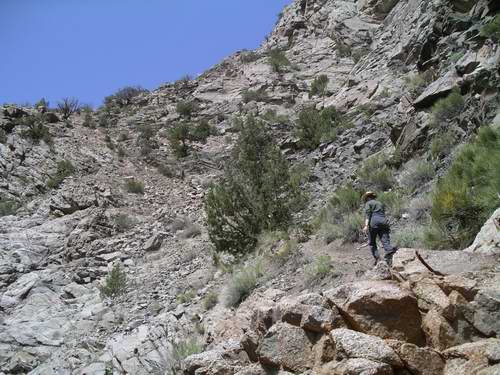
Had the fishing been better it would have been worth the effort, but it really was not. We tried everything for roughly four hours and had only a couple of 16-18 inch browns to show for the work. Both took a black wooly bugger and several others tried to chew that specific streamer but managed to avoid capture. Neither dry flies, nor nymphs, nor any other colored bugger brought much of anything. Quite disappointing results given the work it took to get here. It's highly unlikely we'd ever return. Possibly the cold water temperature this time of year was working against us.
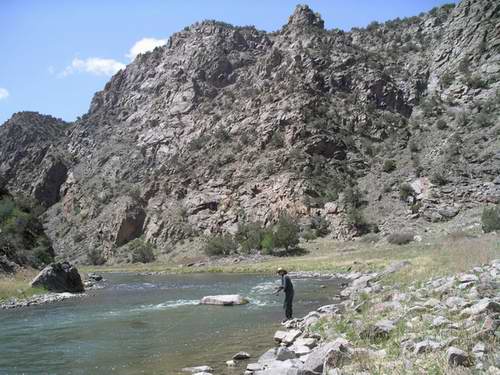
Next week it's off to Lake Powell for a couple of days & then perhaps back up North to the Green for one more session there.
Last Logbook Entry � for previous day
4/7-30: After checking Weather.com's forecast of Utah weather conditions for the upcoming week it looked like an ideal opportunity to combine a trip to two of our favorite fishing spots in that state - Lake Powell and the Green below Flaming Gorge. Although these two spots are diverse in many respects, the temperatures both places were anticipated to be between 55-80 degrees with a possible shower midweek.
Lake Powell came first and the dog & I arrived early afternoon on Tuesday and set out hiking the Bullfrog Bay frontage where we normally camp to test the quality of the fishing with the lake at a new lower than ever level. Two miles of casting later we learned that the lack of decent shoreline structure simply didn't provide any holding water whatsoever for the kind of fishing we do there.
Then drove over to the Stanton Creek primitive camping site and saw that the
lake was almost impossible to access from shore due to the steep canyon walls
that permit only limited hiking close to the water. Nevertheless we did
manage to hook a few smallish smallmouths on wooly buggers before sunset that
night.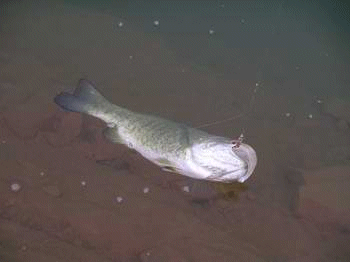
In the morning we walked down into another deep channel area and had much better success. The bass are apparently now on their redds and they are extremely aggressive in attempting to keep intruders at bay. Happily that allowed us to make several casts over individual fish, knowing they'd keep striking until either we were driven off - or they were hooked.
And hooked several of them were. In fact the photo below is roughly a three pound fish, one of the larger of that species we've yet landed in this water. So it was a fun morning despite the difficulties in moving along the ledges of the canyon walls. Probably had a good two dozen fish of varying sizes on before the wind began to blow slightly right at 11:00.
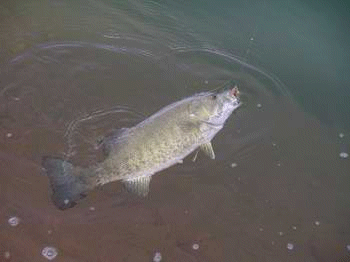
Interestingly by 11:05 the wind was now puffing along at a good 20 knots and showed signs of strengthening.
At 11:10 the gusts were up to an estimated 35 knots, at which point we beat a quick retreat to the car, tuned the radio into the NOAA forecast, and with cautions about a major cold front about to enter the region, packed up & headed North. Dust storms periodically obscured the highway back towards Green River and high profile vehicles were warned to not travel due to the projected 55-65 mile per hour gusts.
Turned North on U.S. 6 and drove to Price planning on spending the night, hoping the weather front would pass so we could then get to the Green with some, hopefully, better conditions. The next morning things turned even uglier with cold rain and mixed snow falling when we left Price and drove over the pass towards Duchesne. The pass was almost im-pass-able and driving was snail's paced. The next local NOAA forecast near our turnoff at Vernal was worse yet. A winter storm warning suggested 12-18 inches of snow on highway 191 and driving was not recommended. Thank you weather.com for your wonderful forecast. It really made our week.
In an effort to salvage something we continued East on 40 and headed to Meeker and our favorite stretch of the White River. Unhappily it was now blown out with runoff, and while we made a few casts in some nice eddies, the presentations were completely rebuffed. Giving up we outran the oncoming thunderstorm back to Glenwood and spent the night at the condo. The Roaring Fork was also high & muddy.
So the last chance for a bit of decent fishing hinged on that stream with which we have had a long term love/hate relationship - the Frying Pan. Being a tailwater it's almost always fishable, but the angling pressures it receives generally makes it a less than fun experience.
Stopped at a large pool around the five mile mark and did manage to land a half dozen twelve inch browns on tiny midge larva. A #24 with a mini glass bead head worked best.
Drove upstream past several stretches already populated by other anglers and finally got to fish a couple of deeper pools with a ginger colored magic bugger. Success! The fish loved the big fly and even better, I could watch them take it in the clear water. It was fascinating to test different types of presentations and gauge the reactions to different drifts or retrieves. Most popular was a hand twist with accompanying rod twitch. While only releasing 7-8 mixed browns and rainbows, I probably had another 20 or so strikes and/or fish played, so it was a very nice finish to what had been a particularly trying week.
Home, Main Fishing Page, , Eagle River Access, Local Ten Commandments, Successful Fly Patterns, Search For Something